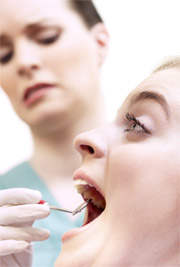- What is dental pain?
- Statistics of dental pain
- Risk factors for dental pain
- Progression of dental pain
- Symptoms of dental pain
- Clinical examination of dental pain
- How is dental pain diagnosed?
- Prognosis of dental pain
- Treatment
- References
What is dental pain?

Statistics of dental pain
Virtually everyone in some way has experienced dental pain or toothache in some form and therefore from personal experience knows of its existence. The most common cause of dental pain is dental caries.
Risk factors for dental pain
Common dental causes of toothache include dental cavities, dental abscess, gum disease, sensitive tooth root (dentine hypersensitivity), cracked tooth, impacted teeth and eruption of teeth.
Dental pain also can be from non dental origin such as angina or heart attack, sinusitis, psychological disorders and tumours.
Progression of dental pain
Dental pain can be either acute dental pain (happening suddenly), or chronic dental pain (happening over a long duration of time). The treatment of the dental pain depends on the nature, onset and the factors causing the pain.
Symptoms of dental pain

- Pain on drinking hot or cold beverages;
- Pain on eating sweet snacks;
- Generally sensitive teeth;
- Pain on biting or during chewing food;
- Severe pain that wakes you up while you are sleeping;
- Severe continuous pain that comes suddenly, without doing anything.
All of the above or any feeling of discomfort might be an indication for you to visit your dentist.
Clinical examination of dental pain
When you visit your dentist, they will ask you a few questions about the nature of your pain, including:
- When did you start to feel pain?
- Does the pain linger for seconds, minutes or hours?
- Is the pain increased with hot, cold or sweet foods?
- Does the pain wake you up at night?
- Can you determine the tooth that causes the pain?
These questions, together with the dental examination, help in recognising the cause of the dental pain.
Get on top of your dental health
Find and instantly book affordable dentists within Australia
How is dental pain diagnosed?
In order to identify what has caused the dental pain, the dentist may use one or more of the following tests.
Test for sensitive teeth
The dentist uses a special device to test if the tooth is still vital (alive), or not. This test may be repeated several times in different appointments.
Cold test
The dentist applies a special cold dental material to the tooth in question. This will aid in diagnosis and decision making whether the tooth needs a root canal treatment or a filling.
Heat test
The dentist applies a special hot dental material to the tooth in question. This will aid in diagnosis and decision making whether the tooth needs a root canal treatment or a filling.
Looking for cavities in your mouth
Using certain examination instruments, the dentist will be able to perform a full check-up to look for dental caries.
Tapping on the teeth
The dentist will use the handle of the dental mirror to tap on the tooth in question and adjacent teeth. This sometimes aids in locating the tooth causing the dental pain.
Check if the teeth are mobile
Using two handles of two dental instruments, or using one handle and one finger, the dentist can check the mobility of the tooth (how much it moves).
Check the structures around the teeth

Biting on cotton or gauze
The dentist places a cotton roll on the tooth in question and asks the patient to close the mouth. This will aid in diagnosis of cracked teeth.
Taking x-rays
X-rays are an important diagnostic test in dentistry, the dentist can inspect hidden areas of the teeth, the bone around the teeth, dental caries, and any other abnormalities.
Prognosis of dental pain
Treatment is dependent on the type and nature of pain. Treatment of the pain may require root canal treatment, removal of the tooth, or simply fluoride application.
Treatment of dental pain

Fluoride application
Fluoride can be supplied in three forms: fluoride varnish, fluoride gel and fluoride mouthwash. The dentist may use a small brush to apply the fluoride varnish or a tray for the fluoride gel. On the other hand the dentist may instruct you to use a fluoride mouthwash at home.
Fillings for your cavities
Generally dentists use white fillings (composite) for anterior teeth (teeth in the front of the mouth) and silver fillings (amalgam) for posterior teeth (teeth in the back).
Scaling and polishing of your teeth
Cleaning your gums and teeth professionally.
Root canal treatment
The dentist will remove the dental pulp (the nerve and blood supply of the tooth), clean and shape the root canal over a series of appointments and then place a sterile filling inside the root canal.
Removal of the tooth
This is simply extraction of the tooth and is always the last treatment option when all other treatments fail.
Antibiotics
Antibiotics may be prescribed as an adjunct to the main dental treatment, especially in cases of bacterial infection (dental abscess). Antibiotics by themselves are not an effective treatment for dental pain.
Pain killers
Pain killers can temporarily relieve dental pain. They are not a definitive treatment because the underlying cause of dental pain still needs to be treated.
Kindly written by Dr Akhil Chandra BDSc(Hons UWA); Dentist, Whitfords Dental Centre, and Editorial Advisory Board Member of the Virtual Dental Centre.
References
-
Cohen S, Hargreaves KM (eds). Pathways of the Pulp (ninth edition). USA: Mosby; 2006.
- Howe G. Local Anaesthesia in Dentistry (third edition). London: Butterworths; 1990.
- Jablonski S. Illustrated Dictionary of Dentistry (first edition). Canada: Saunders Company; 1982.
- Mitchell D. Oxford Handbook of Clinical Dentistry (fourth edition). New York: Oxford University Press; 2005.
- Saladin KS. Anatomy and Physiology: The Unity of Form and Function (third edition). New York: McGraw-Hill; 2004.
- Dowden J (ed). Therapeutic Guidelines: Oral and Dental (first edition). Melbourne: Therapeutic Guidelines Limited; 2007.
- Ingle JI, Bakland LK. Endodontics (fifth edition). London: BC Decker Inc; 2002.
- Abbott PV, Yu C. A clinical classification of the status of the pulp and the root canal system. Aust Dent J. 2007;52(1 Suppl):S17-31.
- Abbott PV. Endodontics and Dental Traumatology: An Overview of Modern Endodontics. Perth: International Federation of Endodontic Associations; 1999.
- Dowell P, Addy M. Dentine hypersensitivity – a review. Aetiology, symptoms and theories of pain production. J Clin Periodontol. 1983;10(4):341-50.
- Consensus-based recommendations for the diagnosis and management of dentin hypersensitivity. J Can Dent Assoc. 2003;69(4):221-6.
- Abbott PV. The periapical space – a dynamic interface. Aust Endod J. 2002;28(3):96-107.
- Zimet PO. Cracked tooth syndrome. Aust Endod J. 1998;24(1):33-7.
- Cameron CE. The cracked tooth syndrome: Additional findings. J Am Dent Assoc. 1976;93(5):971-5.
- Cameron CE. Cracked-tooth syndrome. J Am Dent Assoc. 1964;68:405-11.
- Krell KV, Rivera EM. A six year evaluation of cracked teeth diagnosed with reversible pulpitis: Treatment and prognosis. J Endod. 2007;33(12):1405-7.
- Porto IC, Andrade AK, Montes MA. Diagnosis and treatment of dentinal hypersensitivity. J Oral Sci. 2009;51(3):323-32.
All content and media on the HealthEngine Blog is created and published online for informational purposes only. It is not intended to be a substitute for professional medical advice and should not be relied on as health or personal advice. Always seek the guidance of your doctor or other qualified health professional with any questions you may have regarding your health or a medical condition. Never disregard the advice of a medical professional, or delay in seeking it because of something you have read on this Website. If you think you may have a medical emergency, call your doctor, go to the nearest hospital emergency department, or call the emergency services immediately.







